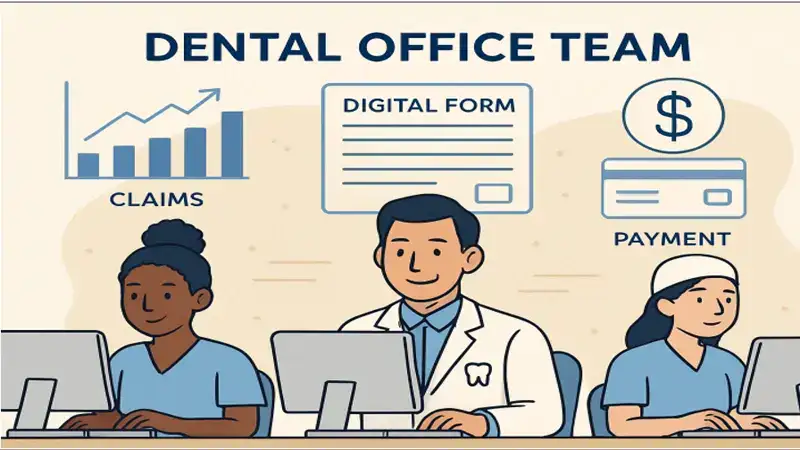Table of Contents
- Automating Claims Processing
- Integrating Practice Management Software
- Enhancing Patient Intake Procedures
- Implementing Real-Time Insurance Verification
- Centralizing Billing Operations
- Regular Training and Education
- Utilizing Data Analytics
- Embracing Telehealth Solutions
Introduction
Enhancing Efficiency in Dental claims processing is pivotal for running a financially healthy and patient-satisfying dental office. From reducing administrative overhead to quicker reimbursements, optimizing the claims and payments workflow eliminates common bottlenecks, minimizes errors, and accelerates practice cash flow. By leveraging technology and best practices in dental claims processing, practices can boost both operational performance and patient confidence in billing accuracy.
Strategic enhancements, such as automation, software integration, and streamlined intake processes, empower teams to focus on patient care rather than paperwork. When these processes are coupled with real-time insurance verification and ongoing staff training, dental practices achieve higher reimbursement rates and smoother day-to-day administration. These best practices pave the way for efficient cash management, timely payments, and fewer billing headaches for both staff and patients.
Automating Claims Processing
Manually handling insurance claims is not only time-consuming but also prone to costly errors, which can result in delayed payments and negatively impact cash flow and patient satisfaction. Transitioning to automated claims processing solutions enables dental practices and other healthcare providers to submit, track, and correct claims electronically in real-time, significantly improving Enhancing Efficiency in Dental. Automation ensures clean claims, reduces the likelihood of errors, and facilitates the swift resolution of discrepancies, thereby freeing staff to focus on more patient-centered and value-added tasks, such as providing quality care and improving the patient experience. Numerous studies from industry leaders and healthcare technology researchers demonstrate that automated dental claims systems result in measurably faster adjudication, reduced administrative burden, and lower rates of denied or resubmitted claims, ultimately leading to enhanced operational efficiency and improved financial stability.
Integrating Practice Management Software
Modern practice management software is the backbone of an efficient Enhancing Efficiency in Dental office. By centralizing appointment scheduling, patient communication, and financial management, these platforms minimize manual touchpoints and streamline workflows. For instance, comprehensive solutions enable teams to monitor the status of claims, generate detailed reports, and access critical patient billing data with a few clicks. These systems not only streamline internal communication but also enhance continuity of care and improve billing transparency for patients.
Enhancing Patient Intake Procedures
Simplifying patient intake reduces administrative load and expedites revenue cycles. Digital intake forms empower patients to submit health history and insurance information online before appointments. This step not only decreases errors stemming from manual data entry but also supports accurate insurance verification and eligibility checks before the patient arrives. Validating information at intake directly translates to fewer claim denials and a smoother patient experience at the front desk.
Implementing Real-Time Insurance Verification
Confirming a patient’s insurance coverage on the spot prevents billing surprises and claim rejections down the road. Real-time verification tools let staff instantly access up-to-date coverage details, copays, deductibles, and even benefit limitations as patients check in. This step enables offices to discuss financial responsibilities with patients transparently, reducing unpaid balances and avoiding the hassles of retroactive insurance denials. Industry sources highlight that real-time verification is one of the most effective ways to bolster claim acceptance rates and improve the accuracy of submitted claims.
Centralizing Billing Operations
Whether consolidating billing into a specialized in-house team or partnering with outside billing experts, centralizing this function significantly increases efficiency across the entire healthcare practice. Centralized billing departments enable the development of standardized processes, facilitate faster follow-up on claims, and provide more accurate and comprehensive reporting. The benefits also include seamless integration with electronic health record (EHR) systems, which support efficient and detailed documentation, maintain thorough audit trails, and ensure compliance with constantly evolving payer requirements. Practices that take steps to streamline billing operations ultimately reduce the risk of overlooked or lost claims, improve overall cash flow, and maximize revenue collection, thereby enhancing both financial stability and patient service quality.
Regular Training and Education
Continued staff education ensures teams are updated on new billing codes, insurance policies, and industry regulations. Providing regular training sessions, webinars, or access to online resources helps billing professionals stay compliant and adapt to changes quickly. Knowledgeable staff are also more equipped to recognize inefficiencies, understand denial reasons, and implement process improvements that enhance both speed and accuracy in billing cycles. Investing in staff development pays dividends in fewer errors, increased collections, and better morale.
Utilizing Data Analytics
Harnessing data analytics enables dental practices to gain a comprehensive understanding of their operational landscape by identifying emerging trends, closely monitoring claim performance, and accurately pinpointing bottlenecks and inefficiencies in their billing process. By thoroughly analyzing reasons for claim denials, payment delays, or recurring administrative setbacks, practices can identify specific opportunities for policy revisions or process adjustments that improve overall workflow. Additionally, data insights support proactive management of insurance contracts, facilitate negotiations with payers, and help prioritize process improvements that ultimately yield the greatest financial return. Practices that commit to making data-driven decisions experience more predictable and stable cash flows, enhanced financial health, and higher overall productivity and efficiency in their daily operations.
Embracing Telehealth Solutions
Telehealth is expanding rapidly in dental care, providing new opportunities to streamline workflows. Virtual consultations and remote follow-up visits not only enhance patient convenience but also reduce operational overhead associated with in-person appointments. Telehealth platforms can synchronize directly with practice management and billing systems, enabling effortless claim documentation, coding, and submissions for remote care. This integrated approach supports higher patient engagement while maintaining efficient, cost-effective billing operations.
Implementing these strategic workflow improvements positions dental offices for success in today’s fast-paced healthcare environment. Focusing on efficiency and leveraging the right technology minimizes administrative friction, accelerates insurance payments, and enhances patient satisfaction, a win for everyone involved. Visit World Life Magazine for more information.

